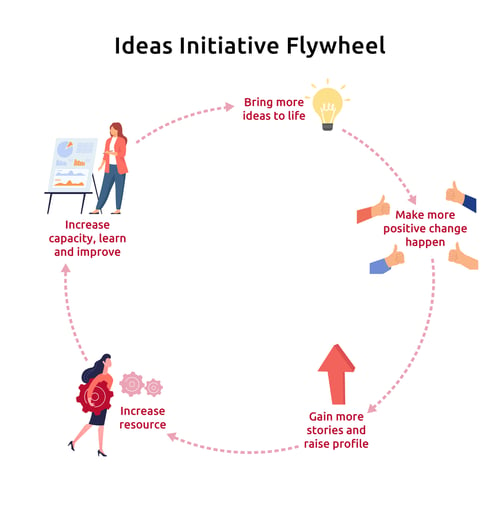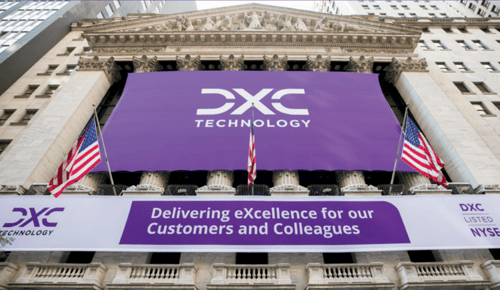+
Get in touch 👋🏽
We would love to hear from you.
Contact us to see how we can help.
We would love to hear from you.
Contact us to see how we can help.
So, what is employee engagement anyway..? And what does it have to do with employee ideas?
Well first up, employee engagement is the emotional commitment that an employee has to an organization and its goals. It is a well-understood metric of business performance that organizations around the world closely measure. As we will see, the impact that employee engagement can have on business performance is, well, staggering.

In this article, we will be exploring some of the reasons that employee engagement efforts fail, how this impacts enterprises and diving into the benefits that proactively listening to employee ideas has on engagement.
If you are looking for employee engagement strategies and an understanding of how to engage employees in your organization’s goals, then this article is for you!
When people are financially invested, they want a return. When people are emotionally invested, they want to contribute.
----- Simon Sinek -----
When employees are engaged, they use discretionary effort within their work. It’s this discretionary effort that allows organizations to grow. However, unlocking how to engage employees at scale is still tricky – most organizations and their HR, people and comms leaders normally look to solutions that focus on:
While these approaches are valid, we will see that focusing on these alone misses a critical opportunity to continually engage employees by making them feel heard while empowering them to become owners of business success.
Let’s jump straight into it and review where we are with employee engagement before exploring a new approach to engage employees more deeply. We will then finish with a look at how Marks and Spencer’s and DXC have increased their employee engagement scores while creating tangible business benefits through employee ideas.
Employee engagement is so crucial because without it, change doesn’t happen, staff leave, and profits drop. These are all things most businesses would like to avoid!
A pretty famous study into business change showed that 70% of business transformation initiatives fail. As we all know, businesses are just organizations of people. When organizations have high levels of employee engagement, they can deliver against their strategic goals; whether that is generating shareholder value, improving internal processes or creating a great place to work.
 Equally, organizations need to retain their best staff and hire great new people to maintain performance. As this Gallup study shows, the impact on employee engagement and retention is significant; companies with high engagement see up to 65% less turnover! Simply put, when employees are engaged, they stay.
Equally, organizations need to retain their best staff and hire great new people to maintain performance. As this Gallup study shows, the impact on employee engagement and retention is significant; companies with high engagement see up to 65% less turnover! Simply put, when employees are engaged, they stay.
This is important because it can cost an organization up to two times the annual salary of employees to replace them. Eek.
Employee engagement also affects productivity, impacting an organization’s bottom line - companies with high levels of employee engagement are 21% more profitable.
Did you know?
In a study conducted with the big box retailer Best Buy, just a 0.1% increase in engagement among employees at a particular store equated to more than a $100,000 uplift in that store’s annual income!
The writing on the wall is clear, to achieve business transformation, retain your best staff and build and maintain profits, your employees have to be engaged and onboard.
You might be aware of this at your organization, but employee engagement is kind of at a low point. The UK is ranked the third lowest across Europe for employee engagement, with engagement dipping by 2% in 2022. In the US, employee engagement has dropped for the first time in 10 years. Globally only 21% of employees are engaged at work. That is a startlingly low number.%20(1).png?width=500&name=William%20Pollard%20(30)%20(1).png)
Of course, there are complex reasons for this decline in employee engagement; COVID-19, changing attitudes to work and a fluctuating job market all play their part.
Low Employee Engagement
There is a big price to pay for poor employee engagement and it is estimated that it costs the economy between $7.8 trillion a year – Source: Gallup
The issue with traditional employee engagement at large companies is that many leaders struggle with lifting employee engagement at scale following a low employee engagement survey score. Typically, a business unit manager teams up with an HR or Comms team member to work together on a specific issue that is pulling down employee engagement scores.
If this manager cannot turn things around for their team, employee engagement in this area of the business stays low. If they can change things, it is a very small part of the organization that this effort affects.
Organizations that fail to engage employees at scale are ultimately the ones that fail to grow.
To better engage employees, many organizations have long moved away from the old world of top-down corporate comms and have introduced two-way communication through employee engagement surveys.
This shift has meant employees have been able to share what they think and feel with the business and the business can get a sense of where employee sentiment is.
However, businesses have since realized that this approach has not fully solved the problem. This kind of survey can become a once-a-year activity that just serves as a snapshot of how employees are doing at that time. For employees, it’s a chance to have their voice heard, but their engagement in the business ends once they anonymously submit their survey response.
The best way to show someone that you are genuinely listening is by showing action based on what you have heard. If someone does something or changes their mind based on something you have told them, you feel like they really heard you, right?
The same is true for employees. Instead of taking reactive actions following once-a-year surveys to try and boost engagement, why not make employees feel genuinely heard by showing them you value their input as well as their feedback?
Being humble and always searching for the best idea possible? That’s listening.
----- Michael C. Bush, CEO @ Great Place To Work -----
Studies show that highly engaged employees are three times more likely to say they feel heard. By asking employees for their ideas and implementing them continuously, you show that what they say matters.
This is how you drive up employee engagement scores at scale. Feeling that you matter to an organization is why you engage in work as well as why you continue working there.
All organizations are looking to change. Markets shift, economies fluctuate, competition increases, and customers demand more. As we explored earlier, for a company to go through a transformation, it must have its people on board. There is no more powerful way to get this buy-in from employees than by making them owners of the transformation you want to see.

The importance of ownership was studied by researcher and author Dan Ariely, who observed and documented the “Ikea Effect”. His research shows that when people play a role in building something, they attach a disproportionately high value to the final product.
By asking employees to share their ideas on how to achieve a change, you increase engagement and make employees the owners of your strategic priorities.
What makes this even more powerful is the fact that 82% of employees already have ideas to improve the business they work for. By pointing this creative energy towards the goal you want to achieve, employees are empowered to take part in the building of a better business. Nice.
No other mechanism exists that has so much power to engage employees in business transformation. It's why the world's best CEOs ask their employees for their ideas.
So, we have seen how making employees feel genuinely heard pushes up employee engagement and that employees will value and own a transformation when they play a part in creating it. In the following sections, we will see how this positively impacts employee engagement at Marks and Spencer and DXC.
However, there is a third and final benefit to engaging employees in this way - the ideas themselves! Asking employees from across the business for their ideas will enable you to find new, intelligent, in-depth and considered solutions from the people who know your organization the best – your employees.

Whether it’s a frontline worker who knows exactly what processes can be improved to save time or an executive who has a new idea on how her business unit can be more sustainable, generating ideas will enable you to find and implement new, previously undiscovered solutions.
The kicker is that by implementing employee ideas, you demonstrate action, thus driving up engagement even further. More engagement and positive change will mean more good ideas; the process is cyclical. We call it the ideas flywheel.
Now we have employee engagement across the business and ownership in company goals increasing. At the same time, the implementation of the very best ideas allows the business to achieve the transformation it wants to see.
When launching an employee ideas campaign, the success lies in the execution. Employees must be able to find campaigns and share their ideas easily; the process should be frictionless, enjoyable and fit easily into their busy day.

Technology adoption is one of the main hurdles to getting a new campaign off the ground. If it’s hard for employees to share their ideas and they have to navigate outside their workflow or simply don’t know where to share their ideas, the ideas campaign and the engagement that follows won’t happen.
Marks and Spencer took an integrated approach when it came to engaging their 70,000 employees across stores up and down the UK in their ideas initiative. Everyone at the legendary retailer uses Microsoft Teams, so it made sense to integrate the process of generating ideas and engaging employees into Microsoft Teams.
With their company-branded ideas apps sitting right alongside their other Microsoft Teams tools like Chat, Calls and Calendar - Marks and Spencer employees can share their ideas with a single tap. The experience was much more engaging than their old ideas email inbox, and employees could see each other’s ideas, like and comment and get involved across different campaigns.
Marks and Spencer employees knew exactly where to share their great ideas and have their voices heard. Adoption was quick, the campaigns successful and the ideas fast flowing.
To transform our business, we need absolutely everyone to play a part. We have 70,000 passionate colleagues, and they know M&S better than anyone.
----- Steve Rowe, CEO @ Marks and Spencer’s -----
By taking the integrated approach, Marks and Spencer’s has seen a 70% increase in the number of ideas shared. Because Marks and Spencer have made employees feel heard and owners of the business goals employee engagement has increased by 5%, leading to a 4% reduction in staff turnover. Pretty amazing.
The ideas they have found and implemented have had a material impact on M&S’s strategic initiatives as well. Their ideas campaign focused on improving customer satisfaction has led to customer net promoter score (NPS) increasing by 19% and their sustainability campaigns have helped them reduce landfill waste by 14%.
Now DXC know a thing or two about engaging employees at scale. With over 130,000 employees following the merger between tech powerhouses, HP Enterprise and CSC, their Simplify DXC campaign was all about engaging employees in improving internal processes. Their campaign was ultimately about giving time back to their employees to focus on the thing that mattered most – the customer!
With such a large number of employees, the DXC team knew they would have many ideas to manage and many more people to keep up to date. The workload involved with managing a campaign like this can be incredibly intimidating.
We want employees to spend time with customers and not have to worry about complicated internal processes.
----- Kim Gennusa, Principle for Strategy @ DXC -----
With all of the benefits that employee ideas bring in the way of great solutions and a boost to employee engagement, no one wants to be managing and sorting through 100’s of ideas and then manually contacting idea submitters to thank them for their idea or give them an update on what is happening.
DXC has been smart and has fully automated the management of ideas through their ideas funnel and the bespoke, personalized comms that go out to idea submitters. Through automation, they effortlessly update thousands of employees both about the ideas that have been submitted and the Simplify DXC campaign itself.
This means engagement in business goals stays high and employees feel that their ideas have been heard and valued. Without this kind of communication, DXC knew submitters would think that their ideas had gone into a black hole and engagement in their campaigns would be low, something they wanted to avoid at all costs!
.png?width=500&name=Sideways%206%20Management%20(3).png)
Organizations like DXC that switch to automation typically spend three times less time managing ideas and get back to employees about their ideas four times quicker. There is no massive workload for the people running the ideas campaign and the personalized communications boost engagement and enable the business to quickly find and bring the ideas with the highest impact to life.
DXC has seen employee engagement increase by an impressive 28.5% and the ideas implemented and time saved have meant the operating margin across the business has increased by 2.3%. Their employees are now the owners of finding and implementing better processes and increasing productivity.
We hope this guide on using employee ideas to drive engagement and ownership has been helpful. As we have seen, making employees feel truly heard positively impacts employee engagement across the business.
By asking employees for their ideas, you make them owners of business goals, ultimately creating more engagement in the things that matter most to your business. And as we saw from Marks and Spencer’s and DXC, the ideas from employees are the solutions that will make the change happen.
So that’s it, folks. To take your employee engagement strategy to new heights, it’s time to get out there and ask employees ideas for their greatest ideas on your biggest goals.
Ideas from Anywhere™
Sideways 6 exists to help bring good ideas to life every day, everywhere from everyone.
»